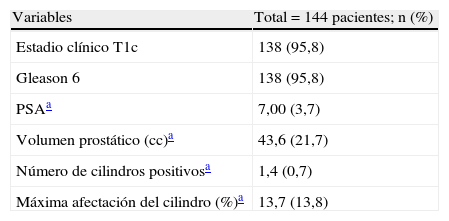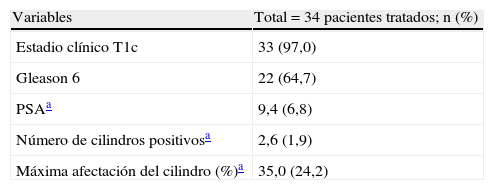Evaluar la aceptación del seguimiento activo por los pacientes en nuestro entorno asistencial y describir los resultados clínicos de un programa de vigilancia activa en pacientes con cáncer de próstata de bajo riesgo.
Material y métodosEstudio prospectivo de pacientes incluidos en programa de vigilancia activa en nuestro centro entre 2004 y 2012. Los criterios de inclusión fueron: PSA <10ng/ml, Gleason ≤6, estadio clínico T1c/T2a, ≤2 cilindros positivos, con una afectación máxima del cilindro del 50%. Se propuso tratamiento curativo ante la progresión anatomopatológica a lo largo del seguimiento.
ResultadosEn el año 2011, del total de pacientes potenciales candidatos, tan solo un 17% de los mismos rechazó la inclusión en un programa de vigilancia y fue tratado de forma activa. Analizamos una serie de 144 pacientes incluidos en nuestro protocolo de vigilancia activa. La media de seguimiento fue de 3,22 años (DE: 2,08). Ciento diez pacientes (76,3%) permanecen en seguimiento activo, con una mediana estimada de supervivencia libre de tratamiento tras el diagnóstico de 6,9 años (IC 95%: 6,2-7,6%). El porcentaje de pacientes que permanecen libres de tratamiento a 2 y 5 años fue de 96,3% (IC 95%: 92,8-99,8%) y 70,9% (IC 95%: 59,3-85,5%) respectivamente. Treinta y cuatro pacientes (23,6%) precisaron tratamiento curativo. La media de tiempo hasta el tratamiento fue de 4,6años (DE: 2,3).
ConclusionesLa vigilancia activa en pacientes altamente seleccionados con cáncer de próstata de bajo riesgo es una alternativa terapéutica válida de tratamiento y aceptada por los pacientes de nuestro entorno.
To evaluate the acceptance of active monitoring by patients treated in our healthcare community and to report the clinical results of an active surveillance program in patients with low-risk prostate cancer.
Material and methodsProspective study of patients enrolled in an active surveillance programme at our centre between 2004 and 2012. The inclusion criteria were PSA <10ng/ml, Gleason score ≤6, clinical stage T1c/T2a, ≤2 positive cores, and no more than 50% of the core being affected. Curative treatment was proposed when faced with pathological progression over the course of the monitoring.
ResultsIn 2011, only 17% of the total number of potential candidate patients rejected their inclusion in a surveillance programme and were treated actively. We analysed a series of 144 patients included in our active surveillance protocol. The mean follow-up time was 3.22 years (SD 2.08). A total of 110 patients (76.3%) remained under active monitoring, with an estimated median treatment-free survival after diagnosis of 6.9 years (95% CI: 6.2-7.6). The percentage of patients who remained free of treatment at 2 and 5 years was 96.3% (95% CI: 92.8%-99.8%) and 70.9% (95% CI: 59.3%-85.5%), respectively. Thirty four patients (23.6%) required curative treatment. The mean time to treatment was 4.6 years (SD 2.3).
ConclusionsActive surveillance of highly selected patients with low-risk prostate cancer is a valid alternative therapy that is accepted by patients in our community.
Artículo
Comprando el artículo el PDF del mismo podrá ser descargado
Precio 19,34 €
Comprar ahora













